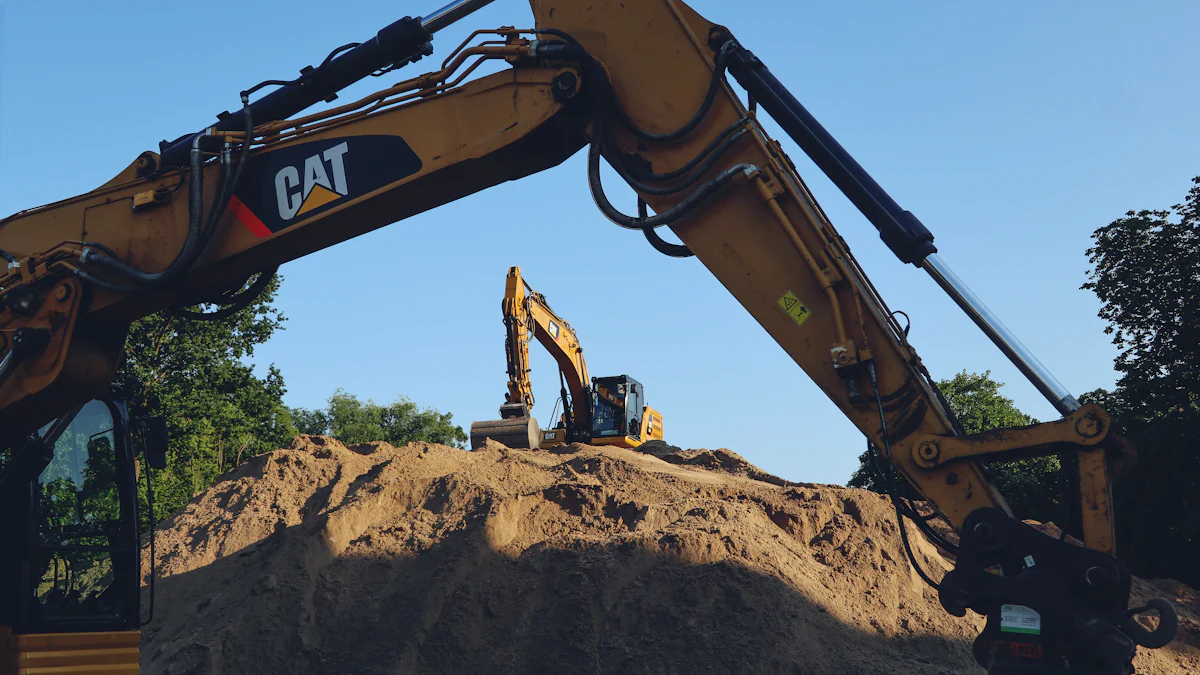
Choosing the right excavator tracks plays a crucial role in keeping your equipment efficient and safe. Poor-quality or mismatched tracks can cause unnecessary wear, reduce performance, and lead to expensive repairs. High-quality tracks ensure smooth operation and minimize downtime. By understanding what makes a track suitable for your machine, you can avoid costly mistakes and maintain productivity on the job site.
Key Takeaways
- 1. Regularly inspect your excavator tracks for signs of wear, such as cracks or uneven tread patterns, to determine when replacements are necessary.
- 2. Choose high-quality rubber tracks that resist wear and are designed for your specific operating conditions to enhance performance and longevity.
- 3. Accurate measurements of width, pitch, and number of links are crucial for selecting the correct size of excavator tracks to avoid performance issues.
- 4. Select the appropriate tread pattern based on your work environment; different patterns provide varying levels of traction and stability.
- 5. Ensure proper fitting and installation of tracks to prevent slippage or excessive wear, following manufacturer guidelines for tension and alignment.
- 6. Implement a regular maintenance routine that includes cleaning, inspecting for damage, and lubricating moving parts to extend the lifespan of your tracks.
- 7. Investing in reputable manufacturers can provide assurance of quality and durability, reducing the risk of costly repairs and downtime.
Identifying the Need for Replacement
Knowing when to replace your excavator tracks is essential for maintaining optimal performance and avoiding costly downtime. Regular inspections and attention to specific signs can help you determine the right time for a replacement.
Signs of Wear and Tear
Worn-out tracks can compromise your excavator’s efficiency and safety. Look for visible cracks, cuts, or missing chunks in the rubber. Uneven wear patterns on the tread indicate improper alignment or excessive use on rough terrain. If the steel cords inside the tracks become exposed, it’s a clear sign that the tracks have reached the end of their lifespan. Regularly checking for these issues ensures you can address them before they escalate.
Performance Issues
Declining performance often signals the need for new tracks. If your excavator struggles to maintain traction or slips frequently, the tracks may no longer provide adequate grip. Reduced stability during operation can also point to worn tracks. Pay attention to unusual vibrations or noises, as these could indicate internal damage. Replacing the tracks promptly can restore your machine’s efficiency and prevent further complications.
Age and Usage
The lifespan of rubber excavator tracks depends on how often and where you use them. Tracks used in harsh environments, such as rocky or abrasive surfaces, wear out faster than those used on softer ground. Even if the tracks appear intact, prolonged use over several years can weaken their structure. Manufacturers often provide guidelines on track longevity, so consider both age and usage when evaluating their condition.
Regular maintenance and timely replacements keep your excavator running smoothly and reduce the risk of unexpected breakdowns.
Evaluating Material Quality for Excavator Tracks

The quality of materials in your excavator tracks directly impacts their durability, performance, and overall value. Understanding the components that make up these tracks helps you make informed decisions and ensures you get the best return on your investment.
Rubber Composition
The rubber used in excavator tracks plays a critical role in their performance and lifespan. High-quality rubber resists wear and tear, even in demanding environments. Look for tracks made with premium rubber compounds designed for flexibility and strength. These compounds help the tracks withstand extreme temperatures and rough surfaces without cracking or breaking. Avoid tracks with low-grade rubber, as they degrade quickly and lead to frequent replacements. Always prioritize durability when evaluating rubber composition.
Internal Components
The internal structure of excavator rubber tracks determines their ability to handle heavy loads and maintain stability. Steel cords and layers of reinforcement inside the tracks provide strength and prevent stretching. Tracks with tightly wound steel cords offer better resistance to tension and reduce the risk of snapping under pressure. Check for seamless construction in the internal components, as this minimizes weak points that could fail during operation. A well-built internal structure ensures your tracks perform reliably in tough conditions.
Manufacturer Reputation
The reputation of the manufacturer often reflects the quality of their excavator tracks. Established brands with a history of producing reliable products are more likely to deliver durable and efficient tracks. Research customer reviews and industry feedback to gauge the performance of a manufacturer’s tracks. Trusted manufacturers also provide warranties and support, giving you confidence in your purchase. Choosing a reputable brand reduces the risk of buying substandard tracks and ensures long-term satisfaction.
Investing in high-quality materials for your excavator tracks enhances their performance and extends their lifespan. By focusing on rubber composition, internal components, and manufacturer reputation, you can select tracks that meet your needs and withstand challenging work environments.
Choosing the Correct Size and Tread Pattern for Excavator Tracks

Selecting the correct size and tread pattern for your excavator tracks ensures optimal performance and prevents unnecessary wear. Proper sizing and tread design directly impact your machine’s efficiency and adaptability to various terrains.
Measuring for the Right Size
Accurate measurements are essential when choosing excavator tracks. Start by checking the dimensions of your current tracks. Measure the width, pitch (distance between links), and the number of links. These three measurements determine the correct size for replacement tracks. Refer to your excavator’s manual for specifications if you’re unsure. Using tracks that don’t fit properly can lead to reduced performance and faster wear. Always double-check measurements to avoid costly mistakes.
Selecting the Right Tread Pattern
The tread pattern of your digger tracks affects traction, stability, and ground impact. Different patterns suit specific terrains and applications. For example:
- (1)Multi-bar tread works well on soft ground, providing excellent traction without damaging the surface.
- (2)Block tread offers durability and stability on hard or rocky terrain.
- (3)C-shaped tread balances traction and smooth operation, making it ideal for mixed surfaces.
Evaluate the conditions where your excavator operates most frequently. Choose a tread pattern that matches those conditions to maximize efficiency and minimize wear.
Application-Specific Considerations
Your work environment and tasks influence the type of excavator tracks you need. Wider tracks distribute weight more evenly, reducing ground pressure. These tracks are ideal for sensitive surfaces like turf or wetlands. Narrower tracks, on the other hand, provide better maneuverability in tight spaces. Consider the load your excavator carries and the frequency of use. Tracks designed for heavy-duty applications last longer under demanding conditions. Always match the track type to your specific operational needs.
Choosing the right size and tread pattern enhances your excavator’s performance and extends the lifespan of its tracks. By understanding your machine’s requirements and the nature of your work environment, you can make informed decisions that save time and money.
Ensuring Proper Fitting and Installation of Excavator Tracks
Proper fitting and installation of excavator tracks are crucial for maintaining your machine’s performance and extending the lifespan of its components. By following best practices, you can avoid unnecessary wear and ensure smooth operation on the job site.
Importance of Proper Fit
The correct fit of excavator tracks directly impacts the efficiency and safety of your equipment. Tracks that are too loose may slip off during operation, causing delays and potential damage. On the other hand, tracks that are too tight can strain the undercarriage, leading to premature wear and costly repairs.
To ensure a proper fit, always refer to the specifications provided in your excavator’s manual. These guidelines include the recommended track size and tension settings. Regularly inspect the tension of your tracks to confirm they are neither too loose nor overly tight. A well-fitted track distributes weight evenly, improving stability and reducing stress on the machine.
Installation Tips
Installing excavator tracks correctly requires attention to detail and adherence to safety protocols. Follow these steps to ensure a successful installation:
- 1.Prepare the Equipment: Park the excavator on a flat, stable surface. Turn off the engine and engage the safety lock to prevent accidental movement.
- 2.Inspect the Undercarriage: Check the undercarriage for debris, damage, or excessive wear. Clean the area thoroughly to ensure a smooth installation process.
- 3.Align the Tracks: Position the tracks properly along the undercarriage. Align them with the sprockets and rollers to avoid misalignment during installation.
- 4.Adjust Tension: Use the tensioning system to achieve the recommended track tension. Refer to the manufacturer’s guidelines for specific instructions.
- 5.Test the Installation: After installing the tracks, operate the excavator at low speed to confirm proper alignment and tension. Address any issues immediately to prevent further complications.
By following these steps, you can install rubber digger tracks safely and efficiently, minimizing downtime and ensuring optimal performance.
Maintenance for Longevity
Regular maintenance plays a vital role in extending the lifespan of your excavator tracks. Neglecting maintenance can lead to accelerated wear and unexpected breakdowns. Incorporate these practices into your routine:
- (1)Clean the Tracks: Remove dirt, mud, and debris after each use. Accumulated debris can cause uneven wear and damage the rubber.
- (2)Inspect for Damage: Check for cracks, cuts, or exposed steel cords. Address minor issues promptly to prevent them from worsening.
- (3)Monitor Tension: Regularly measure track tension and adjust it as needed. Proper tension reduces stress on the undercarriage and prevents premature wear.
- (4)Lubricate Moving Parts: Apply lubricant to the rollers, sprockets, and other moving components. This reduces friction and ensures smooth operation.
Consistent maintenance not only extends the life of your excavator tracks but also enhances the overall efficiency of your equipment. By taking proactive measures, you can avoid costly repairs and keep your machine running at its best.
Choosing the right excavator tracks ensures your machine operates efficiently and reliably. You need to know when to replace worn tracks, evaluate material quality, and select the correct size and tread pattern. Proper fitting and installation also play a key role in maintaining performance. High-quality tracks tailored to your specific needs improve productivity, reduce downtime, and extend equipment lifespan. By applying these tips, you make informed decisions that keep your excavator running smoothly and effectively on any job site.
FAQ
How do I know when to replace my excavator tracks?
You should replace your excavator tracks when you notice visible signs of wear, such as cracks, cuts, or missing chunks in the rubber. Exposed steel cords or uneven tread patterns also indicate the need for replacement. If your machine struggles with traction, stability, or produces unusual noises, it’s time to inspect the tracks closely.
What is the average lifespan of rubber excavator tracks?
The lifespan of rubber tracks depends on usage and operating conditions. Tracks used on soft ground may last up to 2,000 hours, while those exposed to rocky or abrasive surfaces wear out faster. Regular maintenance and proper usage can extend their lifespan. Always refer to the manufacturer’s guidelines for specific recommendations.
Can I use any tread pattern for my excavator tracks?
No, tread patterns should match your work environment. Multi-bar treads work best on soft ground, while block treads handle rocky terrain effectively. C-shaped treads provide versatility for mixed surfaces. Evaluate your job site conditions before selecting a tread pattern to ensure optimal performance.
How do I measure my excavator tracks for replacement?
To measure your tracks, check three key dimensions: width, pitch (distance between links), and the number of links. Use these measurements to find the correct size. If unsure, consult your excavator’s manual for specifications. Accurate measurements prevent fitting issues and ensure smooth operation.
Are wider tracks better for all applications?
Wider tracks reduce ground pressure and minimize surface damage, making them ideal for sensitive environments like turf or wetlands. However, they may not be suitable for tight spaces where maneuverability is crucial. Consider your specific application and work environment before choosing track width.
What materials should I look for in high-quality excavator tracks?
High-quality tracks use premium rubber compounds for durability and flexibility. Look for tracks with tightly wound steel cords and reinforced internal components. These features enhance strength and resistance to wear. Avoid tracks made with low-grade materials, as they degrade quickly.
How can I ensure proper track tension?
To maintain proper tension, follow the guidelines in your excavator’s manual. Regularly inspect the tracks and adjust the tensioning system as needed. Tracks should not be too loose or too tight. Proper tension improves stability and reduces stress on the undercarriage.
Can I install excavator with rubber tracks myself?
Yes, you can install tracks yourself if you follow safety protocols and manufacturer instructions. Prepare the equipment, clean the undercarriage, and align the tracks properly. Adjust the tension according to the manual. Test the installation by operating the machine at low speed to ensure everything is secure.
How often should I clean my excavator tracks?
Clean your tracks after each use, especially if you work in muddy or debris-filled environments. Dirt and debris can cause uneven wear and damage the rubber. Regular cleaning prevents buildup and extends the lifespan of your tracks.
What maintenance practices help extend track life?
To extend track life, clean them regularly, inspect for damage, and monitor tension. Lubricate moving parts like rollers and sprockets to reduce friction. Address minor issues promptly to prevent further damage. Consistent maintenance keeps your tracks in good condition and ensures reliable performance.
Media Contact
Company Name: Gator Track Co., Ltd.
Email: Send Email
Country: China
Website: https://www.gatortrack.com/

